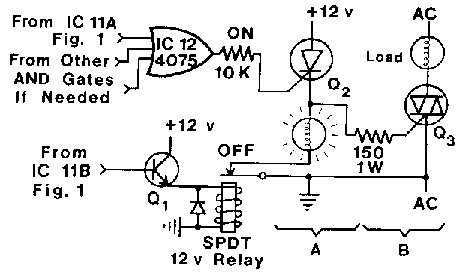Byers, J.A. 1981c. Versatile electronic timer for synchronous
switching of multiple electrical devices. Behavior
Research Methods and Instrumentation 13:381-383.
Abstract--
An electronic timer consisting of CMOS integrated circuits is described
that synchronously switches multiple electrical devices on and off on
either circadian or noncircadian cycles. Precision is attained to within
16.7 msec when used at the highest speed (60 Hz). The electronic timer is
useful for behavioral studies, control of environmental chambers, and
control of general laboratory appliances.
 Figure 1. Electronic timer for synchronous control of multiple electrical devices. The timer will operate
at 50 Hz (European) by connecting RE of IC 4 to pin 1 instead of pin 6 as shown.
Figure 1. Electronic timer for synchronous control of multiple electrical devices. The timer will operate
at 50 Hz (European) by connecting RE of IC 4 to pin 1 instead of pin 6 as shown.
 Figure 2. Circuit controlled by timer for switching dc- (A) or ac- (A and B) powered devices.
Figure 2. Circuit controlled by timer for switching dc- (A) or ac- (A and B) powered devices.
 Figure 3. Noncircuidian photoperiod timer (32 h as shown). Connection of inputs of IC 16 to outputs of ICs
14 and 15 determine the photoperiod (20 H light/12 h dark, as shown). A 32-day timer can be
achieved by connecting the 1 K Ohm resistor of IC 13B to pin 10 of IC 10 from Figure 1. Timers
of 2 to 100 h or days can be achieved by utilizing all 10 outputs of each decade counter (see paper for details).
Figure 3. Noncircuidian photoperiod timer (32 h as shown). Connection of inputs of IC 16 to outputs of ICs
14 and 15 determine the photoperiod (20 H light/12 h dark, as shown). A 32-day timer can be
achieved by connecting the 1 K Ohm resistor of IC 13B to pin 10 of IC 10 from Figure 1. Timers
of 2 to 100 h or days can be achieved by utilizing all 10 outputs of each decade counter (see paper for details).
Chemical Ecology

 Figure 1. Electronic timer for synchronous control of multiple electrical devices. The timer will operate
at 50 Hz (European) by connecting RE of IC 4 to pin 1 instead of pin 6 as shown.
Figure 1. Electronic timer for synchronous control of multiple electrical devices. The timer will operate
at 50 Hz (European) by connecting RE of IC 4 to pin 1 instead of pin 6 as shown.
 Figure 2. Circuit controlled by timer for switching dc- (A) or ac- (A and B) powered devices.
Figure 2. Circuit controlled by timer for switching dc- (A) or ac- (A and B) powered devices.
 Figure 3. Noncircuidian photoperiod timer (32 h as shown). Connection of inputs of IC 16 to outputs of ICs
14 and 15 determine the photoperiod (20 H light/12 h dark, as shown). A 32-day timer can be
achieved by connecting the 1 K Ohm resistor of IC 13B to pin 10 of IC 10 from Figure 1. Timers
of 2 to 100 h or days can be achieved by utilizing all 10 outputs of each decade counter (see paper for details).
Figure 3. Noncircuidian photoperiod timer (32 h as shown). Connection of inputs of IC 16 to outputs of ICs
14 and 15 determine the photoperiod (20 H light/12 h dark, as shown). A 32-day timer can be
achieved by connecting the 1 K Ohm resistor of IC 13B to pin 10 of IC 10 from Figure 1. Timers
of 2 to 100 h or days can be achieved by utilizing all 10 outputs of each decade counter (see paper for details).
